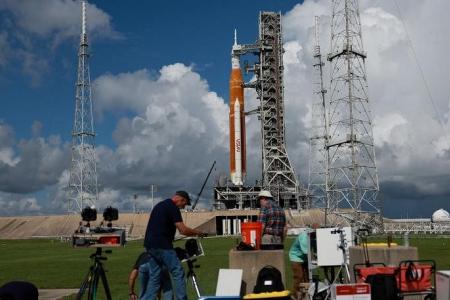'Sight to behold': Tourists flock to Florida for Moon rocket launch
MERRITT ISLAND, UNITED STATES (AFP) - Seeing a rocket blast off to the Moon is "a once-in-a-lifetime thing to experience," says Ms Joanne Bostandji.
The 45-year-old has travelled all the way from northern England to Florida with her husband and two children for a space-themed vacation, and they're prepared to make sure they don't miss a second of the action as US space agency Nasa's newest and most powerful rocket is scheduled to launch for the first time Monday (Aug 29).
"The plan is to drive very early in the morning and get a spot" on Cocoa Beach, she said, not far from the Kennedy Space Center.
"I know it's going to be from a far distance, but I still think it's going to be a sight to behold," Ms Bostandji told AFP as the family waited to enter a park dedicated to space exploration.
Between 100,000 and 200,000 visitors are expected to attend the launch of the mission, called Artemis 1, which will propel an empty capsule to the Moon as part of a test for future crewed flights.
The "historic nature" of Monday's flight, the first of several as the United States returns to the Moon, "certainly has increased public interest," Ms Meagan Happel of Florida's Space Coast Office of Tourism told AFP.
Ms Sabrina Morley was able to find an apartment to rent not far from the beach, and plans to take her two children and other people on a boat chartered for the occasion by a company called Star Fleet Tours.
For US$95 (S$132) a ticket, "we'll go out into the ocean as close as they can get to the launch and we'll watch the launch from the boat," she said. "I've never been this close to a launch before," said the 43-year-old, who grew up in Orlando, less than an hour away.
The return of prestigious space launches is an economic boon for the region. A family of three will spend an average of US$1,300 over four or five days, according to the tourism office.
On the main road to Merritt Island, the peninsula where the Kennedy Space Center is located, Ms Brenda Mulberry's space memorabilia shop is packed with tourists. The last few days have seen an influx of customers, she said.
There is an air of nostalgia for the Apollo rocket programme. It's been 50 years since the last time a crewed mission went to the Moon, in 1972.
The Artemis programme
Artemis is to return humans to the Moon before an eventual voyage to Mars.
Twelve men walked on the Moon between 1969 and 1972 and one of the goals of Artemis is to put the first woman and person of color on the lunar surface.
The name Artemis was chosen to echo that of the Apollo programme that first took humans to the moon.
Artemis, in Greek mythology, was the twin sister of Apollo and a goddess associated with the Moon.
Artemis 1 is a test flight of the 98-metre Space Launch System rocket and the Orion crew capsule that sits on top of it.
Mannequins equipped with sensors will take the place of crew members on the flight, recording vibration, acceleration and radiation levels.
Orion will orbit the Moon before returning and splashing down in the Pacific Ocean.
Artemis 2, planned for 2024, will be a crewed flight that will orbit the Moon but not land on the surface, similar to what Apollo 8 did 56 years earlier.
The four members of the crew will be named before the end of the year, and a Canadian is expected to be among them.
Artemis 3 will be the first to put humans on the Moon since Apollo 17 in December 1972.
It is scheduled for 2025 but may not take place until 2026 at the earliest, according to an independent audit of the programme.
Nasa plans to land the crewed spacecraft on the southern pole of the Moon, where water in the form of ice has been detected.
Nasa has selected billionaire Elon Musk’s SpaceX to build the Moon lander for Artemis 3.
It will serve as a shuttle from the Orion crew capsule to the lunar surface and back.
The Artemis programme also calls for the construction of a space station called Gateway that will orbit the Moon.
The launch of the first two elements – the living quarters module and power and propulsion system – is planned for late 2024 at the earliest by a SpaceX Falcon Heavy rocket.
Astronauts on Gateway would eventually have access to a lander that would allow them to travel to the Moon’s surface and back.
Gateway would also serve as a stopping point for a future trip to Mars, the ultimate objective of the Artemis programme.
While a trip to the Moon takes just a few days, a voyage to Mars would take several months.
Amazing new photo of the moon
Meanwhile two US astrophotographers have come up with a stunning new image of the Moon, taken from right here on Earth.
The 174-megapixel photo shows the moon's colors, craters and glowing aura in spectacular detail.
The two, Andrew McCarthy and Connor Matherne, who spent nine months on the project, have described their work as a tribute to the Artemis programme.
It was put together like a mosaic, each tile made up of thousands of photos. McCarthy shot over 200,000 photos of the moon from Arizona while Matherne shot 500 from Louisiana.
"The colour in this image is real, but presented with increased saturation so it is easily visible to our eyes," McCarthy said.
Get The New Paper on your phone with the free TNP app. Download from the Apple App Store or Google Play Store now


